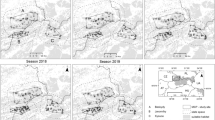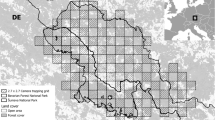Abstract
The Iberian lynx (Lynx pardinus) has a highly restricted geographic distribution, limited even within the Iberian Peninsula. The last national survey reported less than 200 remaining individuals, distributed in two isolated areas—Andújar-Cardeña and Doñana—and in consequence, the Iberian lynx was listed by the International Union for Conservation of Nature as “Critically Endangered”. In this study, we estimate the Iberian lynx population size in the Doñana area using capture–recapture analysis of camera-trapping data. A model with different capture probability for each individual (Mh) yielded an estimate of 26 Iberian lynxes (SE = 5.26) more than 1 year old. It is considered that a small slant in the estimation of the number of individuals could exist due to the presence of dispersers inside the study area that were not detected. Our study shows: (1) a reduction in number since the 1980s (45 individuals), and falling below the theoretical threshold of genetic viability, (2) changes in the species’ spatial distribution in this area, and (3) as for other carnivore species, photographic capture–recapture methods are applicable for estimating the size of Iberian lynx populations


Similar content being viewed by others
References
Anon (1989) Plan Nacional de Coordinación de Doñana y su entorno. Consejería de obras Públicas y Transporte. Junta de Andalucía, Sevilla
Burnham KP, Overton WS (1979) Robust estimation of population size when capture probabilities vary among animals. Ecology 60:927–936
Cabrera A (1914) Fauna ibérica. Mamíferos. Museo Nacional de Ciencias Naturales, Madrid
Curtis PD, Boldgiv B, Mattison PM, Boulanger JR (2009) Estimating deer abundance in suburban areas with infrared-triggered cameras. Hum Wildl Conf 3:116–128
Cutler TL, Swann DE (1999) Using remote photography in wildlife ecology: a review. Wildl Soc Bul 27:571–581
Efford MG, Warburton B, Coleman MC, Barker RJ (2005) A field test of two methods for density estimation. Wildl Soc Bul 33:731–738
Ferreras P (2001) Landscape structure and asymmetrical inter-patch connectivity in a metapopulation of the endangered Iberian lynx. Biol Conserv 100:125–136
Ferreras P, Aldama J, Beltrán JF, Delibes M (1997) Spatial organization and land tenure system of the endangered Iberian lynx (Lynx pardinus), Temminck, 1824). J Zool 243:163–189
Franklin IR (1980) Evolutionary change in small populations. In: Soule ME, Wilcox BA (eds) Conservation biology, an evolutionary-ecological perspective. Sinauer, Sunderland, pp 135–149
Garrote G, García FJ, Guzmán JN, Perez de Ayala C, Iglesias C, Pereira P, Robles F (2001) Aplicación de técnicas de autofotografía en trabajos de conservación de especies amenazadas. El caso del lince ibérico (Lynx pardinus). VI jornadas de la Sociedad Española de Conservación y Estudio de Mamíferos. Vitoria-Gasteiz
Gibbs JP (2000) Monitoring populations. In: Boitani L, Fuller TK (eds) Research techniques in animal ecology. Columbia University Press, New York, pp 213–252
Graells MP (1897) Fauna mastozoologica ibérica. Mem Rea Aca Ciencias XVII. Madrid
Guzmán JN, García FJ, Garrote G, Pérez de Ayala R, Iglesias C (2004) El lince ibérico (Lynx pardinus) en España y Portugal. Censo diagnóstico de sus poblaciones. Dirección General para la Biodiversidad. Madrid
Heilbrun RD, Silvy NJ, Peterson MJ, Tewes ME (2006) Estimating bobcat abundance using automatically triggered cameras. Wildl Soc Bul 34:69–73
Hemker TP, Lindzey FG, Ackerman BB (1984) Population characteristics and movenments patterns of cougars in southern Utah. J Wildl Manag 48:1275–1284
Henschel P, Ray J (2003) Leopards in African rainforests: survey and monitoring techniques. WCS Global Carnivore Program. Wildlife Conservation Society
IUCN (2002) 2002 IUCN red list of threatened animals. IUCN, Gland and Cambridge
IUCN (2007) 2007 IUCN red list of threatened animals. IUCN, Gland and Cambridge
Jackson RM, Roe JD, Wangchuk R, Hunter DO (2006) Estimating snow leopard population abundance using photography and capture–recapture techniques. Wildl Soc Bul 34:772–781
Jacobson HA, Kroll JC, Browning RW, Koerth BH, Conway MH (1997) Infrared-triggered cameras for censusing white-tailed deer. Wildl Soc Bul 25:547–556
Jiménez MA, Sánchez B, Pérez Alenza MD, García P, López JV, Rodriguez A, Munóz A, Martínez F, Vargas A, Peña L (2008) Membranous glomerulonephritis in the Iberian lynx (Lynx pardinus). Vet Immunol Immunopathol 121:34–43
Karanth KU, Nichols JD (1998) Estimation of tiger densities in India using photographic captures and recaptures. Ecology 79:2852–2862
Karanth KU, Nichols JD (eds) (2002) Monitoring tigers and their prey: a manual for researchers, managers and conservationists in tropical Asia. Centre for Wildlife Studies, India
Kelly MJ, Noss AJ, Arispe L, Di Bitetti M, De Angelo CD, Paviolo A, Di Blanco YE, Maffei L (2008) Estimating puma densities from remote cameras across three study sites: Bolivia, Argentina, and Belize. J Mammal 89:408–418
Lancia RA, Nichols JD, Pollock KH (1994) Estimating the number of animals in wildlife populations. In: Bookhout TA (ed) Research and management techniques for wildlife and habitats. The Wildlife Society, Bethesda, pp 215–253
Lebreton JD, Brunham KP, Clobert J, Anderson DR (1992) Modeling survival and testing biological hypotheses using marked animals: a unified approach with case studies. Ecol Monogr 62:67–118
Lopez-Bao JV, Rodrıguez A, Palomares F (2008) Behavioural response of a trophic specialist, the Iberian lynx, to supplementary food: patterns of food use and implications for conservation. Biol Conserv 141:1857–1867
Mitchell-Jones AJ, Amori G, Bogdanowicz W, Krystufek B, Reijnders PJH, Spitzenberger F, Stubbe J, Thissen JBM, Vohralik V, Zima J (1999) The atlas of European mammals. T. and A. D. Poyser Ltd./Societas Europaea Mammalogica, London
Murray DL, Fuller MR (2000) A critical review of the effects of marking on the biology of vertebrates. In: Boitani L, Fuller TK (eds) Research techniques in animal ecology. Columbia University Press, New York, pp 15–64
Otis DL, Burnham G, White C, Anderson DR (1978) Statistical inference from capture data on closed animal populations. Wildl Monogr 62:1–135
Palomares F, Rodriguez A, Laffite R, Delibes M (1991) The status and distribution of the Iberian Lynx Felis pardina (Temminck) in Coto de Doñana, SW Spain. Biol Conserv 57:159–169
Palomares F, Ferreras P, Fedriani JM, Delibes M (1996) Spatial relationships between Iberian lynx and other carnivores in an area of south-western Spain. J App Ecol 33:5–13
Palomares F, Delibes M, Ferreras P, Fedriani JM, Calzada J, Revilla E (2000) Iberian lynx in a fragmented landscape: predispersal, dispersal, and postdispersal habitats. Cons Biol Vol 14(3):809–818
Palomares F, Delibes M, Revilla E, Calzada J, Fedriani JM (2001) Spatial ecology of Iberian lynx and abundance of European rabbits in southwester Spain. Wildl Monogr 148:1–35
Peña L, García P, Jiménez MA, Benito A, Pérez Alenza MD, Sánchez B (2006) Histopathological and immunohistochemical findings in lymphoid tissues of the endangered Iberian lynx (Lynx pardinus). Comp Immunol Microbial Infect Dis 29:114–126
Peterson MN, Lopez RR, Frank PA, Peterson MJ, Silvy NJ (2003) Evaluating capture methods for urban white-tailed deer. Wildl Soc Bul 31:1176–1187
Pollock KH, Nichols JD, Brownie C, Hines JE (1990) Statistical inference for capture–recapture experiments. Wildl Monogr 107:1–97
Rau JR, Beltrán JF, Delibes M (1985) Can the increase of fox density explain the decrease in lynx numbers at Doñana? Rev Ecol (Terre vie) 40:145–150
Rexstad E, Burnham KP (1991) User’s guide for interactive program CAPTURE. Abundance estimation of closed populations. Colorado State University, Colorado
Rivas-Martínez S (1987) Memoria del Mapa de Series de Vegetación de España. 1: 400000. ICONA, Madrid
Rodríguez A, Delibes M (1992) Current range and status of the Iberian lynx Felis pardina Temminck, 1824 in Spain. Biol Conserv 61:189–196
Rodríguez A, Delibes M (2003) Population fragmentation and extinction in the Iberian lynx. Biol Conserv 109:321–331
Seber GAF (1982) The estimation of animal abundance and related parameters, 2nd edn. MacMillan, New York
Shaffer ML, Samson FB (1985) Population size and extintion: a note on determining critical population sizes. Amer Nat 125:144–152
Silver SC, Ostr LET, Marsh LK, Maffei L, Noss AJ, Kelly MJ, Wallace RB, Gomez H, Ayala G (2004) The use of camera traps for estimating jaguar Panthera onca abundance and density using capture/recapture analysis. Oryx 38:148–154
Simón MA (2008) Currente status of Iberian lynx in Andalusia. Proceedings of the III Iberian lynx International Seminar. Andalusia Government, IUCN/SC Cats Specialist Group
Soisalo MS, Cavalcanti SMC (2006) Estimating the density of a jaguar population in the Brazilian Pantanal using camera-traps and capture-recapture sampling in combination with GPS radio-telemetry. Biol Conserv 129:487–496
Soulé ME (1980) Thresholds for survival: maintaining fitness and evolutionary potential. In: Soulé ME, Wilcox BA (eds) Conservation biology: an evolutionary–ecological perspective. Sinauer Associates, Sunderland, pp 151–169
Trolle M, Kéry M (2003) Estimation of ocelot density in the pantanal using capture–recapture analysis of camera-trapping data. J Mamm 84:607–614
Valverde JA (1963) Información sobre el lince en España. Min Agric Bol Tec, Ser Cinegética, 1
Villafuerte R, Calvete C, Gortázar C, Moreno S (1994) First epizooty of rabbit haemorragic disease on free living populations at Doñana National Park (SW Spain). J Wildl Dis 30:176–179
White GC, Burnham KP (1999) Program MARK: survival estimation from populations of marked animals. Bird Study 46:120–138
Zielinski WJ, Kucera TE (1995) American Marten, Fisher, Lynx, and Wolverine: survey methods for their detection. USDA Forest Service General Technical Report PSW GTR-157
Acknowledgments
The fieldwork and the economic support was possible through the collaboration between the Dirección General de Conservación de la Naturaleza (DGCONA-MIMAM, project “Censo-Diagnóstico de las Poblaciones de Lince Ibérico en la Península Ibérica”), Organismo Autónomo de Parques Nacionales-Doñana, Parque Natural de Doñana, Delegación Provincial de Medioambiente de Huelva, and TRAGSA. We thank JA Blanco “J”, E Virgós, JLTellería, and the anonymous reviewers for their constructive comments, and also Ramón Pérez de Ayala Giménez, Ricardo Balzola, John Muddeman, and Yolanda Cortés who helped with the translation.
Author information
Authors and Affiliations
Corresponding author
Additional information
Communicated by C. Gortázar
Rights and permissions
About this article
Cite this article
Garrote, G., Perez de Ayala, R., Pereira, P. et al. Estimation of the Iberian lynx (Lynx pardinus) population in the Doñana area, SW Spain, using capture–recapture analysis of camera-trapping data. Eur J Wildl Res 57, 355–362 (2011). https://doi.org/10.1007/s10344-010-0440-7
Received:
Revised:
Accepted:
Published:
Issue Date:
DOI: https://doi.org/10.1007/s10344-010-0440-7




